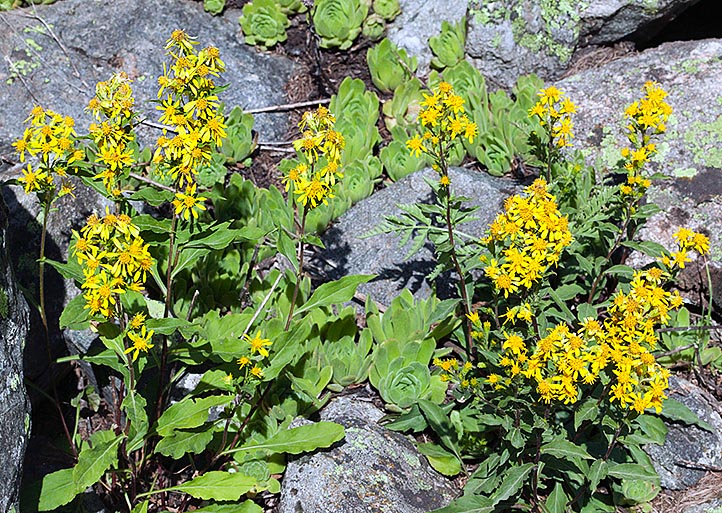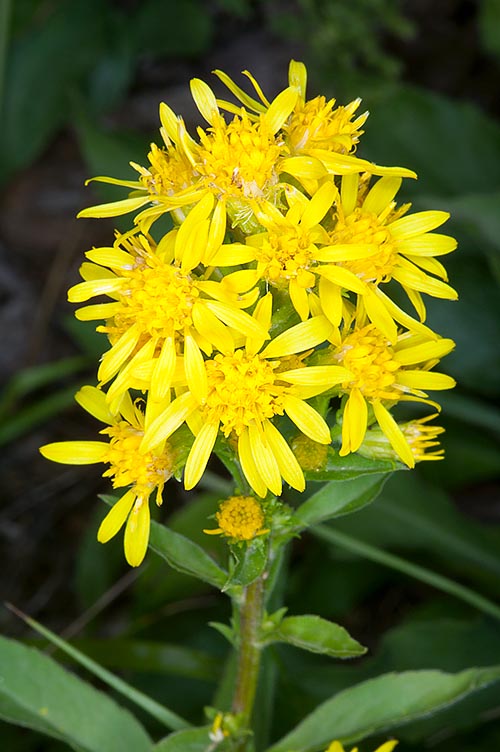Family : Asteraceae

Text © Eugenio Zanotti

English translation by Mario Beltramini

Solidago virgaurea is a 20-80 cm perennial herbaceous growing up to 2500 m of altitude © Giuseppe Mazza
The genus Solidago includes, after various authors, 80 to more than 100 species of north-eastern America, few ones of South America, of Europe and northern Asia.
The name of the genus comes from the Latin “solidus”, solid, healthy, and “agere” to render, make, and unite, therefore, to cicatrize cuts and consolidate fractures, or else from “solidare”, to join, due to the alleged properties of favouring the healing of the bones fractures.
The name of the species “virga aurea” means golden twig, golden rod, with reference to the showy golden yellow capitula. This species was known in the old times also as Judean grass, pagan grass or Saracens’ grass. Perennial herbaceous plant, 20-90 (100) cm tall, equipped with a short knotty rhizome, oblique, brown-reddish and erect stem, rigid, glabrous or little pubescent and streaked above. Lower leaves with 5-8 cm long, winged, petiole and oblanceolate or obovate lamina, glabrous above and usually pubescent below, of 2-3 x 7-9 cm (more developed in those of the basal sterile rosettes), sharp, with indented margin, decreasing upwards, with lanceolate to lanceolate-linear shape, alternated.
Yellow flowers merged in capitula on 1-3 mm pubescent peduncles, cylindrical involucre with 6-8 mm scales, carried in thyrsoid or panicle inflorescence. The flowering takes place from July up to October and pollination is done by the insects (entomogamous). The fruits are cylindrically-shaped achenes, thinned at the ends, pubescent, costiform, of 3 mm, yellowish, surmounted by a pappus of simple hairs. It grows in the woods, thickets, grasslands, wild locations in siliceous soils as well as in calcareous ones, but prefers soils with neutral pH, of average fertility and moderately humid, from the plain up to the 2000 m of altitude.
From the phytosociological point of view, it belongs to the forest communities of the Hornbeam (Fagetea sylvaticae). The subsp. minuta (Alt. subsp. alpestris) da 1800 a 2500 m s.l.m., la subsp. litoralis from 1800 to 2500 m of altitude, the subsp. litoralis (recently raised to the rank of species) in Italy, lives in ditches and pine forests of Versilia coastline and of northern Apennines. Some cultivars gotten from species of the genus Solidago are used in gardening due to the rusticity and the showy flowerings such as Solidago flexicaulis ‘Variegata’, Solidago hybrida ‘Duchy’, Solidago hybrida ‘Golden Mosa’, Solidago hybrida ‘Laurin’, Solidago rugosa, Solidago sempervirens ‘Goldene Wellen’, Solidago gigantea, etc.

Flowers and leaves have medicinal properties © Giuseppe Mazza
The plant contains several active principles, particularly important are the flavonoids (about 1,4%), such as quercetin, quercitrin and isoquercetin, rutin, kempferol, astragalin, isorhamnetin; anthocyanidins, leiocarposide, virgaureoside, sugars, saponins, diterpenoids, essential oil, caffeic and chlorogenic acids, polysaccharides, catechinic tannins, resins and mucilages. The extracts haven besides a mild anti-inflammatory action, also a certain antifungal activity against fungi pathogenic for the man such as Candida albicans. It is a very valid plant also from the cosmetic point of view for rednesses of the skin with an action similar to that of the Calendula.
In homeopathy they use the tincture of fresh flowers against some kidney ailments, nephrolithiasis, gout and hypertrophy of the prostate. Due to its contents in bio-flavonoids with vitaminic activity P, the goldenrod can be used in the varicose syndromes in lieu of the extract of the Indian conker (Aesculus hippocastanum). The popular medicine assigns the goldenrod other properties, many of them, however, are not confirmed by clinical experimentations (anthelmintic, anticoagulant, antipyretic, expectorant, etc.). Presently, the countries where this plant is more cultivated, on small surfaces, are Hungary, former Yugoslav countries, Bulgaria and Poland.
Preparations:
Diuretic, depurative and renal antiseptic infusion
Two spoonfuls of dried plant and 10 juniper berries in one litre of cold water, leave boiling for 2 minutes. Switch off and leave in infusion for 10 minutes more. To filter, sweeten and drink in two days keeping it in the fridge.
Diuretic, digestive, anti-stones wine
Leave macerating for 8 days 60 grams of flowered tops of dried goldenrod in good quality dry white wine and of at least 12 degrees, keeping in cool location and in the dark in a closed vessel, stirring occasionally. To filter squeezing well the residue and drink a small glass at the end of the meals.
Synonyms
Solidago virgaurea L. var. alpina Murith (1810) = subsp. alpestris ; var. humillima Wahlenberg (1814) = subsp. alpestris ; var. ericetorum Duby (1828); var. pumila Gaudin (1829) = subsp. alpestris ; var. cambrica (Hudson) DC. (1836) = subsp. alpestris ; var. minuta (L.) DC. (1836) = subsp. alpestris ; var. nudiflora (Viviani) DC. (1836) = subsp. nudiflora ; var. reticulata (Lapeyr.) DC. (1836) var. bertiana De Not. (1848) = subsp. alpestris ; subsp. alpestris (Waldst. & Kit. ex Willd.) Gremli (1878) ; subsp. macrorhiza (Lange) Nyman (1879) ; subsp. minuta (L.) Arcangeli (1882) = subsp. alpestris ; subsp. nudiflora (Viviani) Nyman (1879); proles alpestris (Waldst. & Kit. ex Willd.) Rouy (1903); subsp. alpestris ; proles alpicola Rouy (1903) = subsp. alpestris ; var. cinerascens Briq. & Cavillier in Burnat (1915); proles cambrica (Hudson) Rouy (1903) = subsp. alpestris ; proles corsica Rouy (1903) ; proles hartmanniana Rouy (1903); proles macrorhiza (Lange) Rouy (1903) ; proles maritima Rouy (1903) ; proles minuta (L.) Rouy (1903) = subsp. alpestris ; proles nudiflora (Viviani) Rouy (1903) = subsp nudiflora ; proles rupicola Rouy (1903) subsp. rupicola ; proles serratifolia (Boreau) Rouy (1903); subsp. rupicola (Rouy) Lambinon in Darimont & al. (1962).
→ To appreciate the biodiversity within ASTERACEAE family please click here.
